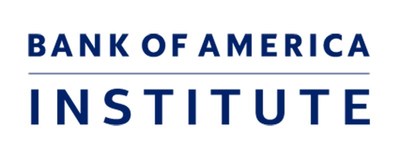Despite cross-currents from such potential factors as a weaker job market, easing inflation, and a rising cost of living, consumers' New Year's resolutions to get healthier may also heat up changes in spending habits
NEW YORK, Jan. 10, 2023 /PRNewswire/ -- Bank of America Institute released new analysis today which shows that, while 2022 was a solid year for consumer spending, the New Year brings with it cross-currents for U.S. consumers, including a potentially weaker job market and easing inflation pressures in 2023. Although January and February are typically lighter months, New Year resolutions to get healthy may provide some support for spending.
BofA aggregated credit and debit card data indicates 2022 was a strong year for consumer spending, with total card spending per household up 5.9% year-over-year (YoY).
There was a stark difference, however, between retail/goods spending and non-retail spending (which includes services such as travel and entertainment); average YoY spending growth for retail in 2022 was 3.7% compared to a much stronger 10% in services.
2023 starts with consumers still facing higher living costs, especially utilities, partially driven by a colder December in 2022 than the prior year. BofA internal data shows that the average utility payment per customer increased 13% YoY in December, even as natural gas prices have dropped by more than 50% since the peak price levels in August 2022. And while the labor market remains tight, there are signs of wage growth moderation. According to BofA internal data, consumer after-tax wages decelerated to 2.7% YoY (3-month moving average) in December, from the high of 8% in April 2022.
With these trends in mind, a new year often signals a fresh start and good intentions, illustrated by an uptick in web searches for "gym memberships" each January. BofA internal data shows that between 2010 and 2019, credit and debit card spending per household at fitness clubs surged in January of each year, after relatively low levels during the winter holiday months. However, as of December 2022, card spending per household at fitness clubs remained 35% lower than pre-pandemic levels. Part of this weakness could be due to the rise of in-home fitness, which gained popularity since the pandemic because of migration out of city centers and a preference for social distancing, especially among older generations.
Other highlights of the Consumer Checkpoint include:
- Total credit and debit card spending per household was up 5.9% YoY for all of 2022, with the YoY rate of growth slowing to 2.2% in December.
- Overall total credit and debit card spend, which makes up over 20% of total payments, was up 4.5% YoY in December, as total payments growth across all channels (Automated Clearing House (ACH), Bill Pay, Credit and Debit Card, Wires, Person-to-Person, Cash and Check) increased 1.4% YoY.
- In 2022, in-home fitness spending (based on both cards and ACH) accounted for 16% of total fitness spending on average, down from 24% in 2020 but higher than the 11% in 2019.
"After a solid year in 2022, we expect the consumer to feel the weight of 2023. However, for now, they are heading to the gym in OK financial shape" said David Tinsley, senior economist for Bank of America Institute. "While the year is just beginning, a reduction in cost-of-living pressures and some easing in the labor market are expected to play a big role in determining the evolution of consumer spending."
About the Consumer Checkpoint
Consumer Checkpoint is a regular publication from Bank of America Institute. It aims to provide a holistic and real-time estimate of US consumers' spending and their financial well-being, leveraging the depth and breadth of Bank of America proprietary data. Such data is not intended to be reflective or indicative of, and should not be relied upon as, the results of operations, financial conditions, or performance of Bank of America.
See the Consumer Checkpoint for methodology and definitions.
About Bank of America Institute
Bank of America Institute is dedicated to uncovering powerful insights that move business and society forward. Established in 2022, the Institute is a think tank that draws on data and analyses from across the bank and the world to provide timely and original perspectives on the economy, Environmental, Social and Governance (ESG), and global transformation. The Institute leverages the depth and breadth of the bank's proprietary data, from 67 million consumer and small business clients, 54 million verified digital users, $3.8T in total payments in 2021 and $1.4T in consumer and wealth management deposits. From this robust data set, the Institute provides a unique perspective on the health of the economy. It also elevates thought leadership from throughout the bank that addresses long-term trends and shares these findings with the general public.
Bank of America
Bank of America is one of the world's leading financial institutions, serving individual consumers, small and middle-market businesses and large corporations with a full range of banking, investing, asset management and other financial and risk management products and services. The company provides unmatched convenience in the United States, serving approximately 68 million consumer and small business clients with approximately 3,900 retail financial centers, approximately 16,000 ATMs, and award-winning digital banking with approximately 56 million verified digital users. Bank of America is a global leader in wealth management, corporate and investment banking and trading across a broad range of asset classes, serving corporations, governments, institutions and individuals around the world. Bank of America offers industry-leading support to approximately 3 million small business households through a suite of innovative, easy-to-use online products and services. The company serves clients through operations across the United States, its territories and approximately 35 countries. Bank of America Corporation stock (NYSE: BAC) is listed on the New York Stock Exchange.
For more Bank of America news, including dividend announcements and other important information, visit the Bank of America newsroom and register for news email alerts.
Reporters may contact:
Miranda Caruso, Bank of America
Phone: 1.332.238.8374
miranda.caruso@bofa.com
View original content to download multimedia:https://www.prnewswire.com/news-releases/bofa-data-finds-that-2022-was-a-solid-year-for-consumer-spending-but-the-new-year-brings-new-challenges-301717743.html
SOURCE Bank of America Corporation

































